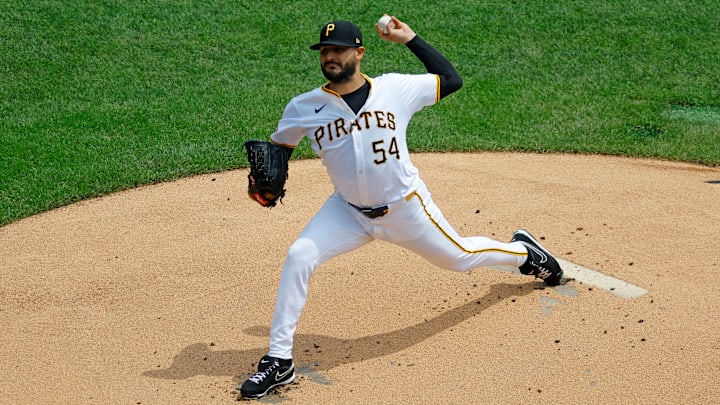In the final days leading up to the July 30 MLB trade deadline, Pittsburgh Pirates fans' confidence in general manager Ben Cherington was waning. The team had worked itself into the National League wild card race, giving Cherington the opportunity to be a deadline buyer for the first time in his five years at the helm of the front office.
Did Cherington know that? Did he even know how to be a buyer? For a team that had been "focused on the future" (read: not competitive) for so many years, this was unfamiliar territory. One by one, top trade targets the Pirates had been linked to for the past several weeks were coming off the board and landing with other teams. For Pirates fans, the outlook was bleak.
Finally, in the final hour leading up to Tuesday's 6 p.m. deadline, there were signs of life in Pittsburgh. At the last minute, Cherington pulled the trigger on what would be the Pirates' biggest moves of the day, acquiring outfielder Bryan De La Cruz and utility player Isiah Kiner-Falefa.
He did it! He actually made the team better! But ... did he do enough? Let's take a look at some of the missed opportunities for Cherington and the Pirates at the 2024 MLB trade deadline.
Pirates didn't add a legitimate impact bat at the deadline
The Pirates finally landed the outfield bat they so desperately needed when they acquired De La Cruz from the Miami Marlins in exchange for a pair of prospects. De La Cruz definitely packs a punch, joining the Pirates' lineup tied with Bryan Reynolds for the most home runs on the team with 18.
His .248 batting average is respectable – certainly an upgrade over Pittsburgh's other outfield options aside from Reynolds – but his alarmingly high strikeout rate (26.2%) and low on-base percentage (.291) shouldn't be overlooked. Still, his raw power is appealing to a team that has the third-lowest OPS in the league (.669).
Then, there's Kiner-Falefa, who is in the midst of a career season at the plate. Through 82 games with the Toronto Blue Jays, he's hitting .292 with a .758 OPS. He has eight doubles, two triples, seven home runs and 33 RBI. He's a high-contact guy who will put the ball in play, but his value lies more in his defensive ability.
Did the Pirates improve their offense at the deadline? Unequivocally, yes. But they could have done more. De La Cruz and Kiner-Falefa have the potential to be solid hitters. So does Nick Yorke, the second base/outfield prospect the Pirates acquired from the Boston Red Sox in exchange for right-handed pitcher Quinn Priester. But nobody stands out significantly as the kind of true impact bat fans were hoping for – at least, not right now.
Pirates gave away Martin Pérez for practically nothing
Pittsburgh's lone true "sell" move at the deadline was sending left-handed starting pitcher Martin Pérez to the San Diego Padres. In doing so, they shaved off an $8 million salary and a back-of-the rotation lefty, whose presence had become redundant at best and a gross overpay at worst. All well and good.
But according to Dejan Kovacevic of DK Pittsburgh Sports, the Pirates are paying half of Pérez's prorated annual salary in San Diego (just over $1.3 million). So, maybe it wasn't as big of a financial win for Pittsburgh as we thought. In return, Pittsburgh got Ronaldys Jimenez, an 18-year-old pitching prospect from the Dominican Summer League who reportedly made Cherington's scouts "giddy."
OK ... but an 18-year-old? Really? Jimenez may very well be a high-upside prospect, but it stands to reason that the Pirates could have at least gotten a prospect who was a little bit closer to being major-league ready. A DSL player hardly seems worth retaining salary on Pérez, especially when the goal is to dump said salary. The Pirates also don't really need more pitchers in their farm system; they need more bats.
Pirates may have done too little, too late
The Pirates got better at the trade deadline, albeit incrementally. But why did it take so long for them to do anything at all? Perhaps if they had been more ambitious, they could have landed a bigger fish of the Randy Arozarena or Jazz Chisholm Jr. variety – and they could have done it without waiting until the last minute.
The Pirates are essentially one of six teams vying for three wild card spots in the National League. While this is certainly an improvement over where this team was a year ago, it means absolutely nothing if the front office doesn't make a real, concerted effort to procure a competitive advantage that will tip the scales in their favor.
Adding a couple of average bats and a couple of average relievers does make the Pirates better than they were a week ago. No one is arguing that. But it may not have been enough to move the needle if this team's goal is to seriously contend for a playoff spot.
But, alas, that's the Cherington way. Even when this team is in a position to buy, they still go bargain hunting. And why? Because they don't want to disrupt their farm system? News flash: that farm system only has four prospects in MLB's Top 100, and only one of them is playing at the Triple-A level. Cherington is in his fifth year as GM and has yet to spend the money required to make any substantial upgrades to the Pirates' major league roster. When will the "incremental improvements" end?
More Pirates content from Rum Bunter
